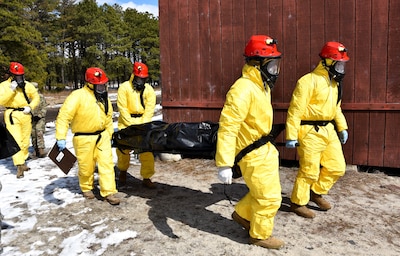By Air Force Tech. Sgt. Robert M. Trujillo, Armed Forces
Medical Examiner System
DOVER AIR FORCE BASE, Del., March 16, 2018 — More than 200
active duty and reserve service members and personnel from the Armed Forces
Medical Examiner System participated in Operation Joint Recovery at Joint Base
McGuire-Dix-Lakehurst, New Jersey, March 7-10.
The Defense Department mortuary affairs exercise involved
search and recovery missions in tactical and nontactical environments,
operating a mortuary affairs contaminated remains mitigation site, and
establishing and operating a mortuary affairs collection point and a theater
mortuary evacuation point.
AFMES’ primary role in the exercise was to familiarize
participants in contaminated remains recovery, processing and procedural
guidance and to provide an operational assessment.
Army Col. Louis N. Finelli, the AFMES director, said the
exercise was “a great opportunity” for his staff to share their knowledge with
different services and with local and national agencies, explaining that the
mortuary affairs contaminated remains mitigation site was developed to act as a
stopgap to recovery of contaminated remains, which he called “a relatively new
scenario.”
Contaminated remains are casualities from an attack of a
chemical, biological, radiological, nuclear or explosive nature.
Evolving Idea
Finelli said that being unable to return contaminated
remains first was recognized as a gap during the first years of Operation Iraqi
Freedom, but the idea of a mortuary affairs contaminated remains mitigation
site has evolved over the past two to three years, as technology and procedures
are constantly evolving.
“In the past two years, we have made tremendous strides in
the MACRMS process, but we are always examining for ways to improve the mission
of bringing our troops home,” Finelli said.
Participants had to put these strides to the test during the
exercise, as members were subjected to a simulated CBRNE attack and had to use
techniques, tactics and procedures developed by the Joint Mortuary Affairs
Center.
Application of protective suits, gloves, breathing
filtration gear, wireless cameras and the use of drones were all used for
safety and security during the simulated recovery of service members.
A Teaching Experience
“It was definitely a teaching experience -- for most, it was
their first time seeing a MACRMS in the field,” said Navy Lt. Cmdr. Bryan
Platt, AFMES forensic pathologist. “I tried to demonstrate what they would
encounter during a real-world scenario.”
AFMES also provided medical examiners, investigators and
mortuary affairs specialists to the exercise.
“Most people don’t know how U.S. service member causalities
are recovered in foreign conflicts overseas or stateside,” said Jairo E.
Portalatin, AFMES medicolegal death investigator. “It can be a very sensitive
process, but we owe it to our service members to train and get it right.”
Mike Leone, AFMES safety, environmental and occupational
health manager, acted as the exercise incident commander. He said that in
addition to the MACRMS, scenarios also included a downed aircraft, a tornado
disaster, and combat search and recovery missions.
In each case, he said, participants had to locate, recover
and process simulated human remains, sometimes weighing more than 200 pounds.
“These exercises and training scenarios are extremely
beneficial for us,” said Marine Corps Sgt. Keith A. Norman, logistics chief for
Detachment Personnel Retrieval and Processing Company, Combat Logistics
Regiment 45. “For some of our younger Marines, it’s the first time they’ve
worked in a joint environment.”
Finelli said integration of multiple organizations in a
joint environment is a key focus of these types of exercises.
“By conducting these exercises,” he said, “we hope to
introduce to our service members the experience and training needed to support
worldwide contingency operations and disaster response operations.”

No comments:
Post a Comment